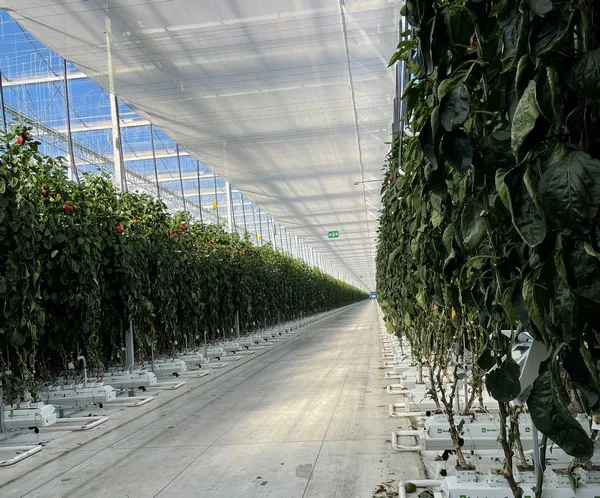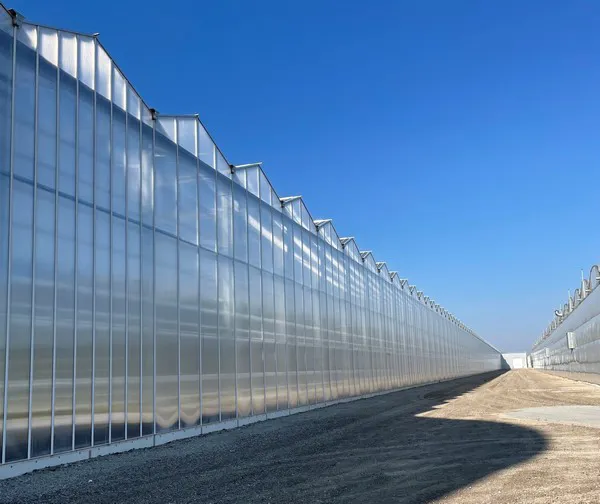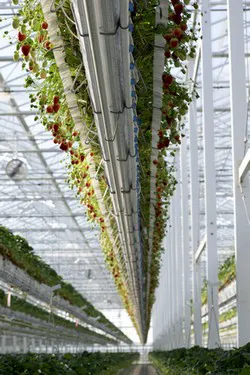The differences between greenhouse produce growers in Canada and greenhouse operators in the U.S. are significant, according to Burk Metzger, General Manager of Produce at Prospiant.
“A lack of strong operational experience, limited market access, and the absence of a suitable migrant labor program are holding up development in the US greenhouse market,” Metzger says.
Metzger has lots of opportunities to observe how greenhouse produce markets in the U.S. and Canada are developing. Prospiant is a leading U.S.-based provider of turnkey controlled-environment agriculture (CEA) solutions, as well as a manufacturer and supplier of custom greenhouses. Only a year ago, Gibraltar united its growing and processing companies; Rough Brothers (RBI), Nexus, Thermo Energy Solutions, Delta Separations, Apeks Supercritical, and Tetra, under the Prospiant name, creating a player with local market access to the complete Northern American controlled environment agriculture (CEA) industry.
“The extent of services we provide as Prospiant is unique,” Metzger says. “If it looks like a greenhouse, smells like a greenhouse, then we can do it. Whether it’s a Venlo greenhouse, an aquarium enclosure for a zoo, a carwash structure or an old conservatory that needs an update, we have somebody in our group that can handle it.”

Operational excellence critical for strong growth
The last year has been a rough one for the larger CEA industry. Investments were halted and expansion plans postponed as the industry dealt with supply chain and economic headwinds for the first time in many years. Even in Ontario, the projects slowed down a bit, although not as abruptly as in the U.S.
“If you look at the owners and operators of greenhouses, there are some noticeable differences between Canada and the U.S.,” Metzger says. “Both are serving the U.S. market – more than 80% of the Ontario Greenhouse production is exported. Ontario companies have strong operational experience, as they grew organically from family companies. The Canadian industry consolidated into four or five big marketing companies, to counter consolidation on the retail side, and these billion-dollar players are driving the expansion of the greenhouse acreage to secure and control supply. All of the big players have partnered with deep pocket patient investors, capitalizing on their market access and operational experience and are poised to expand.”

On the other side, the U.S. has seen strong growth over the last decade, thanks to extensive investments from various parties. However, since quite a few companies started without market access or experience in cultivation, the financial results have not been as good as expected, “In the U.S., setting up a new operation might start with raising money and telling a good story. But making that operation into a success however, involves project design, good execution, operation excellence, and market access,” Metzger says.
Investors expect consistent, predictable results, which are hard to achieve in a fluctuating market like the fresh produce one. Unless an operation is diversified, it is difficult to achieve projected yields. “Even if projected yields are attained within a couple of years, but the projected financial results are often based on the price of top quality produce, sold in an expensive package. “What if the size of your peppers decreases because it’s hot? What if your tomatoes are too small? What if your yield is second grade quality, and thus second grade price level? The lack of growing knowledge, of agricultural knowledge, often results in projections that are too high and unrealistic,” Metzger says.
Lack of labor limits progress
Then there’s labor. “Another thing that’s holding up development in the US is a shortage of greenhouse workers. The local labor market is bare and available migrant labor programs do not meet the needs of current day greenhouse operations. Whereas in Canada, there’s the opportunity to have international workers join a company year-round, the U.S. H2A program offers seasonal hire of foreign workers only. Modern greenhouse operations have a year round labor demand and a seasonal program with a 2 month supply gap per year is not a match. There are experienced growers with a foot in the U.S., but the lack of access to workers is holding them back from executing big plans in the U.S.,” according to Metzger.

Start-ups must have market access to prosper
A common mistake new greenhouse start-ups make with their sales forecasts is to assume they will get year-round prices in markets where they do not have a contract. Without a signed contract, they have no guarantee to rely upon.
“People are falling prey to the image of CEA being a sexy industry; that it is all about robotics and AI, they think it is much further advanced in deployment than it is,” Metzger says. “Leafy greens and herbs can be automated quite easily, which is why the focus tends to be on those crops. Sales-wise though, trucking lettuce alone doesn’t pay, and growers must offer more than that to catch retailers attention.”
Growers need to look at the big picture
The concept of locating production close to population centers sounds good, but logistically production needs to tie into already established distribution channels, so proximity to DC’s and the ability to provide the DC with the whole produce category is more important. "This coordinated category management is not happening on the US side of the border," according to Metzger.
What is Prospiant’s role in all this? “We see the opportunities in the industry, but we also see the importance of looking at the complete picture and we try to help our customer see that as well,” Metzger says.
For example, the Venlo greenhouse model is dominating the greenhouse market right now. Venlo greenhouses are semi-closed or closed facilities equipped with climate control, humidity control, active cooling systems, and more. Technological possibilities aside, Metzger points out that it is important for growers to be aware of the costs to operate a facility, and the market potential for their crops.
If a grower needs to literally move a mountain to make space for his greenhouse, he might want to consider a different location because his CAPEX will be so high he won’t realize a return on investment. And it might be nice to have a perfect growing climate in Florida, but not if your products end up as a commodity in a flooded market..
Prospiant is committed to customer success
Prospiant tries to make new companies aware of the things they need to consider before starting a new produce operation. As a North American based company that manufactures and pays its taxes in the U.S. and Canada, Prospiant is not a one-man office trying to sell only. It is part of the CEA industry, so the company wants its clients to succeed. This mindset comes with obligations.
“If I hand you the key to a turnkey Prospiant greenhouse, I need to be accessible,” Metzger says. “Our team consists of many former growers and sales people with a seasoned background in the CEA industry. We understand the market and feel we have a responsibility towards the market.”

Over the last couple of months, many of the supply chain challenges growers dealt over the last year have calmed down. Aluminum prices are somewhat stable, and glass is more readily available. The transportation costs are not where they were in the past, but they have improved.
“Horticulture wouldn’t be horticulture if new challenges didn’t arise,” Metzger says. “The biggest challenge we see currently is with components. Mid voltage electrical and control components. Transformers switch-gear, and some fans are pushing 12 -18 month lead times. Most other greenhouse components are back to normal lead times.” The improving supply chain is good news for greenhouse builders because the pressure is high to turn projects around quickly, Metzger says. Some projects that were on pause have become more of a priority for growers in the last couple of weeks due to the discontinued sale of a major CEA player.
“We’re seeing people executing contracts in April and May, and hoping to plant in November– which is a challenging five to six-month project execution timeline,” Metzger says, adding that Prospiant is up to the challenge. “It can be done We recently turned a project around for Mucci in five months. We know what we’re doing and we aren’t starting from scratch.”
For more information:
Prospiant
5513 Vine St,
Cincinnati OH 45217
info@prospiant.com
www.prospiant.com
